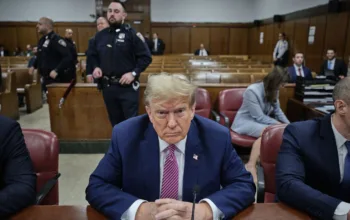
The public and research support gun control. Here’s how it could help — and why it doesn’t pass.
On Thursday, it happened again: another mass shooting. This time, the gunman killed five people at the Capital Gazette offices in Annapolis, Maryland.
Already, the mass shooting has given rise to new calls for gun control laws. Gabrielle Giffords, a former member of Congress who became a major advocate for gun control after an assassination attempt, said in a statement, “Reporters shouldn’t have to hide from gunfire while doing their jobs. A summer intern in the newsroom shouldn’t have to tweet for help. We shouldn’t have to live in a country where our lawmakers refuse to take any action to address this uniquely American crisis that’s causing so much horror and heartbreak on what feels like a daily basis.”
But if this plays out like the aftermath of past mass shootings, from Sandy Hook Elementary School in 2012 to Las Vegas in 2017, the chances of Congress taking major action on guns is very low.
This has become an American routine: After every mass shooting, the debate over guns and gun violence starts up once again. Maybe some bills get introduced. Critics respond with concerns that the government is trying to take away their guns. The debate stalls. So even as America continues experiencing levels of gun violence unrivaled in the rest of the developed world, nothing happens — no laws are passed by Congress, nothing significant is done to try to prevent the next horror.
So why is it that for all the outrage and mourning with every mass shooting, nothing seems to change? To understand that, it’s important to grasp not just the stunning statistics about gun ownership and gun violence in the United States, but America’s very unique relationship with guns — unlike that of any other developed country — and how it plays out in our politics to ensure, seemingly against all odds, that our culture and laws continue to drive the routine gun violence that marks American life.
1) America’s gun problem is completely unique
No other developed country in the world has anywhere near the same rate of gun violence as America. The US has nearly six times the gun homicide rate as Canada, more than seven times as Sweden, and nearly 16 times as Germany, according to UN data compiled by the Guardian. (These gun deaths are a big reason America has a much higher overall homicide rate, which includes non-gun deaths, than other developed nations.)
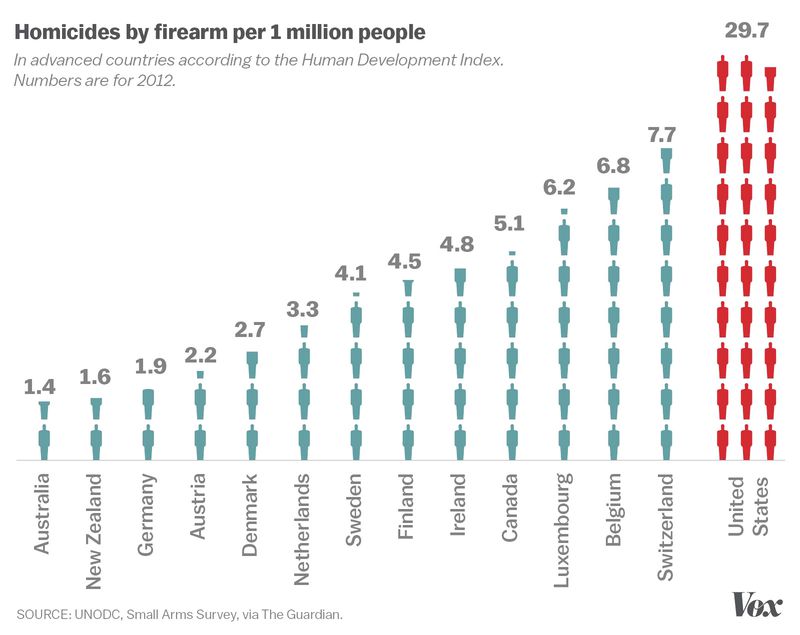 Javier Zarracina/Vox
Javier Zarracina/VoxTo understand why that is, there’s another important statistic: The US has by far the highest number of privately owned guns in the world. Estimated in 2007, the number of civilian-owned firearms in the US was 88.8 guns per 100 people, meaning there was almost one privately owned gun per American and more than one per American adult. The world’s second-ranked country was Yemen, a quasi-failed state torn by civil war, where there were 54.8 guns per 100 people.
/cdn.vox-cdn.com/uploads/chorus_asset/file/4120446/gun%20ownership.png)
Another way of looking at that: Americans make up less than 5 percent of the world’s population, yet own roughly 42 percent of all the world’s privately held firearms.
That does not, however, mean that every American adult actually owns guns. In fact, gun ownership is concentrated among a minority of the US population — as surveys from the Pew Research Center and General Social Survey suggest.
/cdn.vox-cdn.com/uploads/chorus_asset/file/4036522/gun%20ownership.png)
These three basic facts demonstrate America’s unique gun culture. There is a very strong correlation between gun ownership and gun violence — a relationship that researchers argue is at least partly causal. And American gun ownership is beyond anything else in the world. At the same time, these guns are concentrated among a passionate minority, who are typically the loudest critics against any form of gun control and who scare legislators into voting against such measures.
2) More guns mean more gun deaths. Period.
The research on this is overwhelmingly clear: No matter how you look at the data, more guns mean more gun deaths.
This is apparent when you look at state-by-state data for gun ownership and gun deaths (including homicides and suicides) within the United States, as this chart from Mother Jones demonstrates:
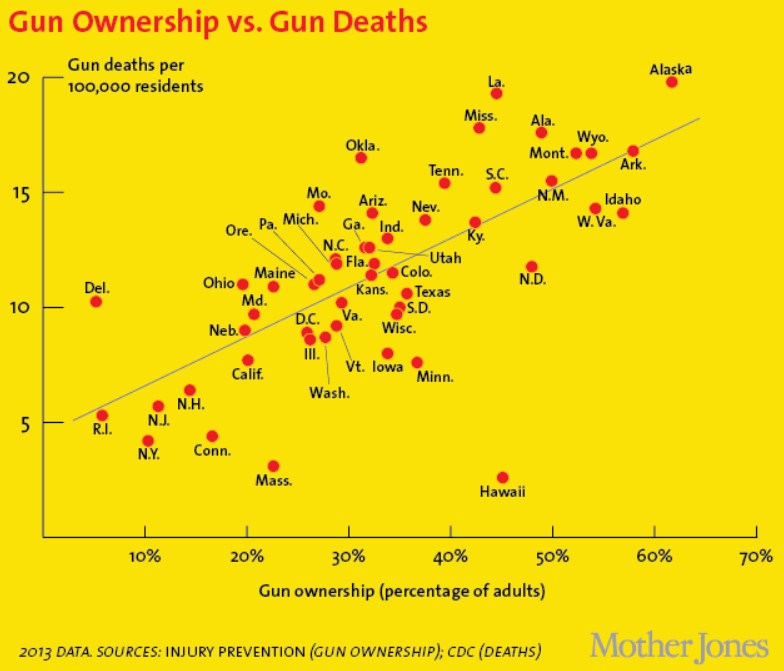 Mother Jones
Mother JonesAnd it’s clear when you look at the data for gun ownership and gun deaths (including homicides and suicides) across developed nations, as this other chart based on data from researcher Josh Tewksbury shows:
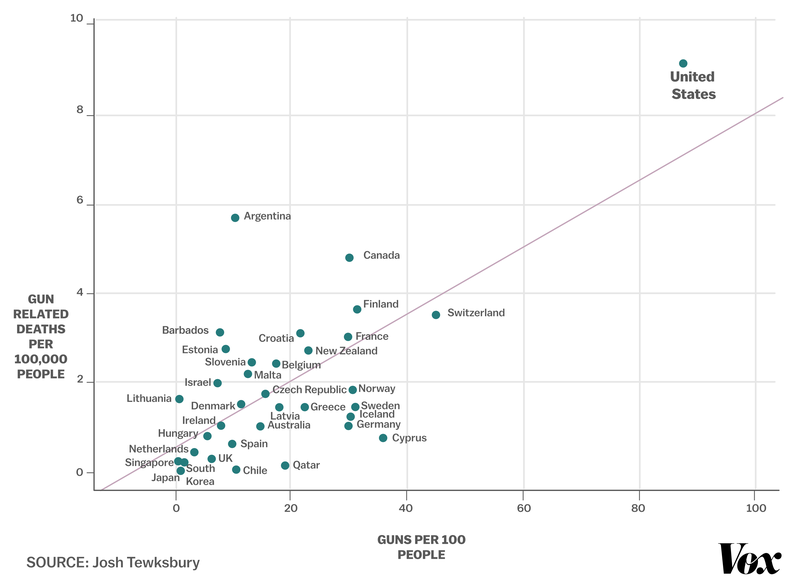 Javier Zarracina/Vox
Javier Zarracina/VoxOpponents of gun control tend to point to other factors to explain America’s unusual levels of gun violence — particularly mental illness. But people with mental illnesses are more likely to be victims, not perpetrators, of violence. And Michael Stone, a psychiatrist at Columbia University who maintains a database of mass shooters, wrote in a 2015 analysis that only 52 out of the 235 killers in the database, or about 22 percent, were mentally ill. “The mentally ill should not bear the burden of being regarded as the ‘chief’ perpetrators of mass murder,” Stone concluded. Other research has backed this up.
Another argument you sometimes hear is that these shootings would happen less frequently if even more people had guns, thus enabling them to defend themselves from a shooting.
But, again, the data shows this is simply not true. High gun ownership rates do not reduce gun deaths, but rather tend to coincide with increases in gun deaths. While a few people in some cases may use a gun to successfully defend themselves or others, the proliferation of guns appears to cause far more violence than it prevents.
Multiple simulations have also demonstrated that most people, if placed in an active shooter situation while armed, will not be able to stop the situation, and may in fact do little more than get themselves killed in the process.
This video, from ABC News, shows one such simulation, in which people repeatedly fail to shoot an active shooter before they’re shot:
The relationship between gun ownership rates and gun violence rates, meanwhile, is well established. Reviews of the evidence, compiled by the Harvard School of Public Health’s Injury Control Research Center, have consistently found that when controlling for variables such as socioeconomic factors and other crime, places with more guns have more gun deaths. Researchers have found this to be true not just with homicides, but also with suicides, domestic violence, and even violence against police.
For example, a 2013 study, led by a Boston University School of Public Health researcher, found that, after controlling for multiple variables, each percentage point increase in gun ownership correlated with a roughly 0.9 percent rise in the firearm homicide rate.
As a breakthrough analysis by UC Berkeley’s Franklin Zimring and Gordon Hawkins in the 1990s found, it’s not even that the US has more crime than other developed countries. This chart, based on data from Jeffrey Swanson at Duke University, shows that the US is not an outlier when it comes to overall crime:
 Javier Zarracina/Vox
Javier Zarracina/VoxInstead, the US appears to have more lethal violence — and that’s driven in large part by the prevalence of guns.
“A series of specific comparisons of the death rates from property crime and assault in New York City and London show how enormous differences in death risk can be explained even while general patterns are similar,” Zimring and Hawkins wrote. “A preference for crimes of personal force and the willingness and ability to use guns in robbery make similar levels of property crime 54 times as deadly in New York City as in London.”
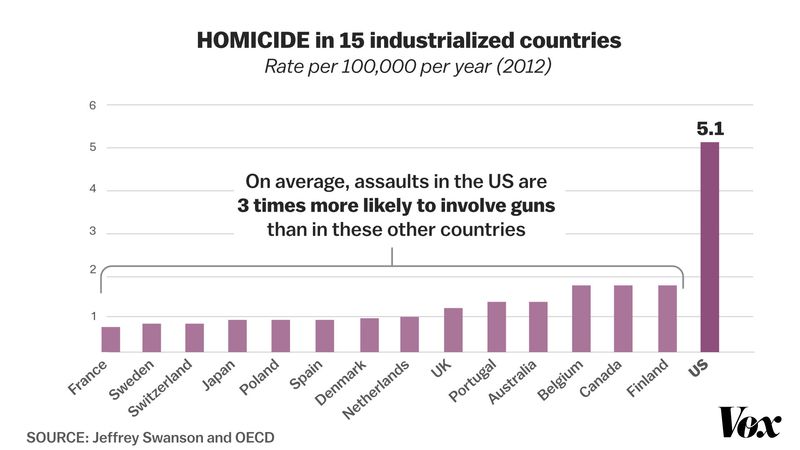 Javier Zarracina/Vox
Javier Zarracina/VoxGuns are not the only contributor to violence. (Other factors include, for example, poverty, urbanization, and alcohol consumption.) But when researchers control for other confounding variables, they have found time and time again that America’s high levels of gun ownership are a major reason the US is so much worse in terms of gun violence than its developed peers.
To deal with its problem, America will have to not only make guns less accessible, but likely reduce the number of guns in the US as well.
The research also speaks to this point: A 2016 review of 130 studies in 10 countries, published in Epidemiologic Reviews, found that new legal restrictions on owning and purchasing guns tended to be followed by a drop in gun violence — a strong indicator that restricting access to guns can save lives.
But even with the outrage over gun massacres, the sense that enough is enough, and the clear evidence that the problem is America’s high gun ownership rates, there hasn’t been significant legislation to help solve the problem.
3) Americans tend to support measures to restrict guns, but that doesn’t translate into laws
If you ask Americans how they feel about specific gun control measures, they will often say that they support them. According to Pew Research Center surveys, most people in the US support universal background checks, a federal database to track gun sales, bans on assault-style weapons, and bans on high-capacity magazines.

So why don’t these measures ever get turned into law? That’s because they run into another political issue: Americans, increasingly in recent years, tend to support the abstract idea of the right to own guns.
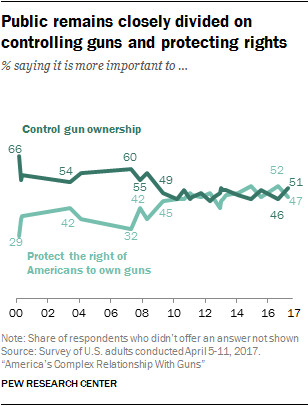
This is part of how gun control opponents are able to kill even legislation that would introduce the most popular measures, such as background checks that include private sales (which have upwards of 80 percent support, according to Pew): They’re able to portray the law as contrary to the right to own guns, and galvanize a backlash against it.
This kind of problem isn’t unique to guns. For example, although many Americans say they don’t like Obamacare, most of them do in fact like the specific policies in the health care law. The problem is these specific policies have been masked by rhetoric about a “government takeover of health care” and “death panels.” Since most Americans don’t have time to verify these claims, especially when they involve a massive bill with lots of moving parts, enough end up believing in the catchphrases and scary arguments to stop the legislation from moving forward.
Of course, it’s also the case that some Americans simply oppose any gun control laws. And while this group is generally outnumbered by those who support gun control, the opponents tend to be much more passionate about the issue than the supporters — and they’re backed by a very powerful political lobby.
4) The gun lobby as we know it is relatively recent but enormously powerful
The single most powerful political organization when it comes to guns is, undoubtedly, the National Rifle Association (NRA). The NRA has an enormous stranglehold over conservative politics in America, and that development is more recent than you might think.
The NRA was, for much of its early history, more of a sporting club than a serious political force against gun control, and even supported some gun restrictions. In 1934, NRA president Karl Frederick was quoted as saying, “I do not believe in the general promiscuous toting of guns. I think it should be sharply restricted and only under licenses.”
A 1977 revolt within the organization changed everything. As crime rose in the 1960s and ’70s, calls for more gun control grew as well. NRA members worried new restrictions on guns would keep coming after the historic 1968 law — eventually ending, they feared, with the government’s seizure of all firearms in America. So members mobilized, installing a hard-liner known as Harlon Carter in the leadership, forever changing the NRA into the gun lobby we know today.
This foundation story is crucial for understanding why the NRA is near-categorically opposed to the regulation of private firearms. It fears that popular and seemingly common-sense regulations, such as banning assault-style weapons or a federal database of gun purchases, are not really about saving lives but are in fact a potential first step toward ending all private gun ownership in America, which the NRA views — wrongly, in the minds of some legal experts — as a violation of the Second Amendment of the US Constitution.
So any time there’s an attempt to impose new forms of gun control, the NRA rallies gun owners and other opponents of gun control to kill these bills. These gun owners make up a minority of the population: anywhere from around 30 to around 40 percent of households, depending on which survey one uses. But that population is a large and active enough constituency, particularly within the Republican base, to make many legislators fear that a poor grade from the NRA will end their careers.
As a result, conservative media and politicians take the NRA’s support — especially the coveted A-to-F ratings the organization gives out — very seriously. Politicians will go to sometimes absurd length to show their support for gun rights. In 2015, for example, Sen. Ted Cruz (R-TX) starred in a video, from IJ Review, in which he cooked bacon with — this is not a joke — a machine gun.
Although several campaigns have popped up over the years to try to counteract the NRA, none have come close to capturing the kind of influential hold that the organization has.
Kristin Goss, author of The Gun Debate: What Everyone Needs to Know, previously told me this might be changing. She argued that newer gun control groups like Everytown for Gun Safety and Americans for Responsible Solutions are much more organized, are better funded, and have more grassroots support than gun control groups have had in her decades covering this issue. As a result, Democrats at the state and federal levels seem much more willing to discuss gun control.
But supporters of gun control face a huge obstacle: far more passionate opponents. As Republican strategist Grover Norquist said in 2000, “The question is intensity versus preference. You can always get a certain percentage to say they are in favor of some gun controls. But are they going to vote on their ‘control’ position?” Probably not, Norquist suggested, “but for that 4-5 percent who care about guns, they will vote on this.”
What’s behind that passion? Goss, who’s also a political scientist at Duke University, suggested that it’s a sense of tangible loss — gun owners feel like the government is going to take their guns and rights. In comparison, gun control advocates are motivated by more abstract notions of reducing gun violence — although, Goss noted, the victims of mass shootings and their families have begun putting a face on these policies by engaging more actively in advocacy work, which could make the gun control movement feel more relatable. (See: #NeverAgain.)
There is an exception at the state level, where legislatures have passed laws imposing (and relaxing) restrictions on guns. In the past few years, for instance, Washington state and Oregon passed laws ensuring all guns have to go through background checks, including those sold between individuals. “There’s a lot more going on than Congress,” Goss said. “In blue states, gun laws are getting stricter. And in red states, in some cases, the gun laws are getting looser.”
But state laws aren’t enough. Since people can cross state lines to purchase guns under laxer rules, the weaker federal standards make it easy for someone to simply travel to a state with looser gun laws to obtain a firearm and ship it to another state. This is such a common occurrence that the gun shipment route from the South, where gun laws are fairly loose, to New York, where gun laws are strict, has earned the name “the Iron Pipeline.” But it also happens all across the country, from New York to Chicago to California. Only a federal law could address this issue — by setting a floor on how loose gun laws can be in every state. And until such a federal law is passed, there will always be a massive loophole to any state gun control law.
Yet the NRA’s influence and its army of supporters push many of America’s legislators, particularly at the federal level and red states, away from gun control measures — even though some countries that passed these policies have seen a lot of success with them.
5) Other developed countries have had huge successes with gun control
In 1996, a 28-year-old man walked into a cafe in Port Arthur, Australia, ate lunch, pulled a semiautomatic rifle out of his bag, and opened fire on the crowd, killing 35 people and wounding 23 more. It was the worst mass shooting in Australia’s history.
Australian lawmakers responded with legislation that, among other provisions, banned certain types of firearms, such as automatic and semiautomatic rifles and shotguns. The Australian government confiscated 650,000 of these guns through a mandatory gun buyback program, in which it purchased the firearms from gun owners. It established a registry of all guns owned in the country and required a permit for all new firearm purchases. (This is much further than bills typically proposed in the US, which almost never make a serious attempt to immediately reduce the number of guns in the country.)
The result: Australia’s firearm homicide rate dropped by about 42 percent in the seven years after the law passed, and its firearm suicide rate fell by 57 percent, according to one review of the evidence by Harvard researchers.
It’s difficult to know for sure how much of the drop in homicides and suicides was caused specifically by the gun buyback program and other legal changes. Australia’s gun deaths, for one, were already declining before the law passed. But researchers David Hemenway and Mary Vriniotis argue that the gun buyback program very likely played a role: “First, the drop in firearm deaths was largest among the type of firearms most affected by the buyback. Second, firearm deaths in states with higher buyback rates per capita fell proportionately more than in states with lower buyback rates.”
One study of the program, by Australian researchers, found that buying back 3,500 guns per 100,000 people correlated with up to a 50 percent drop in firearm homicides, and a 74 percent drop in gun suicides. As Dylan Matthews noted for Vox, the drop in homicides wasn’t statistically significant because Australia has a pretty low number of murders already. But the drop in suicides most definitely was — and the results are striking:
/cdn.vox-cdn.com/uploads/chorus_asset/file/4124128/firearm%20suicides%20australia.jpg)
Javier Zarracina/Vox
One other fact, noted by Hemenway and Vriniotis in 2011: “While 13 gun massacres (the killing of 4 or more people at one time) occurred in Australia in the 18 years before the [Australia gun control law], resulting in more than one hundred deaths, in the 14 following years (and up to the present), there were no gun massacres.”
6) Although they get a lot of focus, mass shootings are a small portion of all gun violence
Depending on which definition of a mass shooting one uses, there are anywhere from a dozen to hundreds of mass shootings in the US each year. These events are, it goes without saying, devastating tragedies for the nation and, primarily, the victims and their families.
Yet other, less-covered kinds of gun violence kill far more Americans than even these mass shootings. Under a broad definition of mass shooting, these incidents killed fewer than 500 people in the US in 2016. That represents less than 2 percent of the nearly 39,000 gun deaths that year — most of which were suicides, not homicides.
Preventing suicides isn’t something we typically include in discussions of gun control, but other countries’ experiences show it can save lives. In Israel, where military service is mandatory for much of the population, policymakers realized that an alarming number of soldiers killed themselves when they went home over the weekend. So Israeli officials, as part of their solution, decided to try forcing the soldiers to keep their guns at the base when they went home. It worked: A study from Israeli researchers found that suicides among Israeli soldiers dropped by 40 percent.
So while politicians often lean on mass shootings to call for gun control, the problem goes far beyond those incidents. Though it’s hard to fault them for trying; mass shootings, after all, force Americans to confront the toll of our gun laws and gun culture.
But it seems that we as a nation just aren’t willing to look, or else don’t sufficiently mind what we see, when these events occur. Even the 2012 mass shooting at Sandy Hook Elementary School, in Newtown, Connecticut — in which a gunman killed 20 young children, six school personnel, and himself — catalyzed no significant change at the federal level and most states. Since then, there have been, by some estimates, more than 1,600 mass shootings. And there is every reason to believe there will be more to come.
Read More
https://cdn.vox-cdn.com/community_logos/52517/voxv.png

